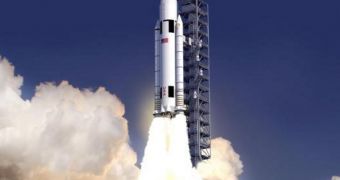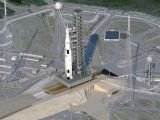During a conference held yesterday, September 14, officials at the American space agency announced the designs for the newest vehicle NASA will start developing, the Space Launch System (SLS) heavy-lift rocket. The machine is impressive indeed.
Its main role is to be capable of putting between 70 and 129 tons (150,000 to 280,000 pounds) in low-Earth orbit. If this capability is attained, then smaller payloads could be sent to much more distant locations. Such payloads may include manned or unmanned spacecraft.
The SLS was designed specifically to be compatible with the Orion Multi-Purpose Crew Exploration vehicle (MPCV) Lockheed Martin is developing for the American space agency. This is in tune with US President Barack Obama's 2010 National Space Policy.
Under the new set of guidelines, NASA needs to work towards putting astronauts on a near-Earth asteroid by 2025, and conduct a manned mission to Mars by the mid-2030s. The Orion MPCV will play a significant role in all these events.
“This launch system will create good-paying American jobs, ensure continued U.S. leadership in space, and inspire millions around the world,” NASA Administrator Charles Bolden said yesterday.
“President Obama challenged us to be bold and dream big, and that's exactly what we are doing at NASA. While I was proud to fly on the space shuttle, tomorrow's explorers will now dream of one day walking on Mars,” he added, quoted in a NASA press release.
SLS will include both Space Shuttle Program and Project Constellation components, experts say. The existing systems were cannibalized for proven hardware in order to reduce development and operations costs, which are already shaping up to be rather large.
The core stage of the rocket will use the SSP's RS-25D/E engines, which burn liquid hydrogen and liquid oxygen. The famous J-2X engines will go on the SLS's upper stage, NASA announced. The agency plans to conduct the first developmental flight by the end of 2017.
Orion will soar to the skies aboard a Delta IV Heavy rocket in July 2013. This will be its first flight test, conducted with the OFT-1 developmental vehicle. SLS and the MPCV are expected to fly together for the first time beyond 2020.
A core feature of the new rocket, NASA experts said, is that it's a modular launch vehicle, meaning that numerous aspects can be custom-tailored for each specific flight, using an array of components and spare parts that are interchangeable.
“NASA has been making steady progress toward realizing the president's goal of deep space exploration, while doing so in a more affordable way,” NASA Deputy Administrator Lori Garver added.
“We have been driving down the costs on the Space Launch System and Orion contracts by adopting new ways of doing business and project hundreds of millions of dollars of savings each year,” she said.
According to early estimates, the entire development program will cost about $18 billions by 2017, which is the equivalent of about $3 billion per year. These costs include the $10 billion needed for the SLS components.
The rest of the funds will go towards finishing the development of the Orion MPCV, as well as towards necessary modifications to launch sites at the NASA Kennedy Space Center (KSC), in Florida.
“I think that now that the administration has come forward, everyone is on the same page on the numbers, the numbers are within the authorization levels – I think we're now moving forward as a team for America,” US Senator Kay Bailey Hutchison (R.-Texas) said at the meeting.
“That's where we all want it to be. Sometimes the making of the sausage isn't pretty, but I think we're on the right end,” he added. The Congressman has been an avid supporter of the SLS since it was first proposed.

 14 DAY TRIAL //
14 DAY TRIAL // 
